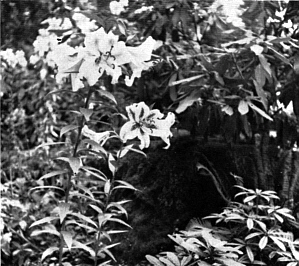Lilies in a Rhododendron Garden
By Cecil Smith, Aurora, Oregon
The desirability of associating lilies with rhododendrons has been mentioned by English garden writers for many years. I also find that they compliment each other here in the Willamette Valley.
Seven or eight years ago, I acquired bulbs and seeds of a few species and hybrid lilies, and now have about thirty different kinds. This limited experience has been enough to cause me to prefer to plant lilies above other bulbs and perennials with rhododendrons.
I choose varieties which flower after the rhododendrons are through, and the fresh young growth of the latter serve as a green background for the lilies. Different varieties grow from two to seven, or even ten feet high, providing a wide choice to fit a particular location.
In a woodland location, as we have here, with a fair amount of room, ten or twenty bulbs of a kind planted twelve to twenty inches apart make a better effect than smaller groups.
The shade requirements of the two genera are about the same. The
auratums
and
cardiocrinum giganteum
, as examples, need shade for five or six hours during the hot part of the day, as do the large leaved rhododendrons. Some enjoy almost full sun with small leaved rhododendrons.
When I speak of shade requirements, I mean, of course, that for our own garden. The need for shade varies greatly for the gardens of different readers of this Quarterly, and climatic differences have to be considered in the site for a planting, rather than the advice of someone thousands of miles away. The summer climate here in the Portland area is exactly the reverse of what a number of writers from other areas have described it. During the three month period from mid-June to mid-September, there is very little rain, and the humidity, instead of being near the saturation point, is sometimes below thirty for weeks, and relative humidity of fifty in summer is rare. Rhododendrons, and most lilies, if planted in full sun and not watered, would soon dry up and die. Our native lilies are the exception, and our native rhododendrons only grow in the mountains and along the ocean.
Most lilies, as do rhododendrons, grow best in soil high in organic material, and on the acid side. Fresh animal manure, however, will not do for lilies, and even partially decayed manure may be the cause of one of the various root and bulb rots to which a few of the finest lilies are highly susceptible.
The moisture requirements of the two groups of plants are about the same. I like to withhold water from the rhododendrons after the first of August as much as possible to harden them off. This tapering off of water seems to be agreeable with all but August flowering lilies. They appear to need water at their roots all summer.
A cultural program which keeps a planting of rhododendrons happy will, with very minor changes, be to the liking of lilies.

|

|
|
Fig. 38.
L. speciosum
growing amongst
rhododendron. Cecil Smith photo |
Fig. 39.
L. auratum
in the woodland
garden. Cecil Smith photo |
Lilium speciosum
(Fig. 38) and
auratum
(Fig. 39) are my best liked species.
Speciosum
and its varieties thrive and multiply here.
Auratums
keep building up for four or five years until many have twenty or thirty buds on them, which may open to eight or ten inches in diameter. Then about that time the root rot gets them, or if it does not, the mosaic does. However, new crosses and back-crosses between
speciosums
and
auratums
with, perhaps, a little blood of a third species, are being made by lily hybridizers. Many of these are said to be much more disease resistant than their parents, and they come in variety enough to please anyone. Yearbooks by the North American Lily Society, and by the R. H. S. are excellent sources of information.
Lilies have added much to the summer interest in our garden, without adding too much to the time required for maintenance.